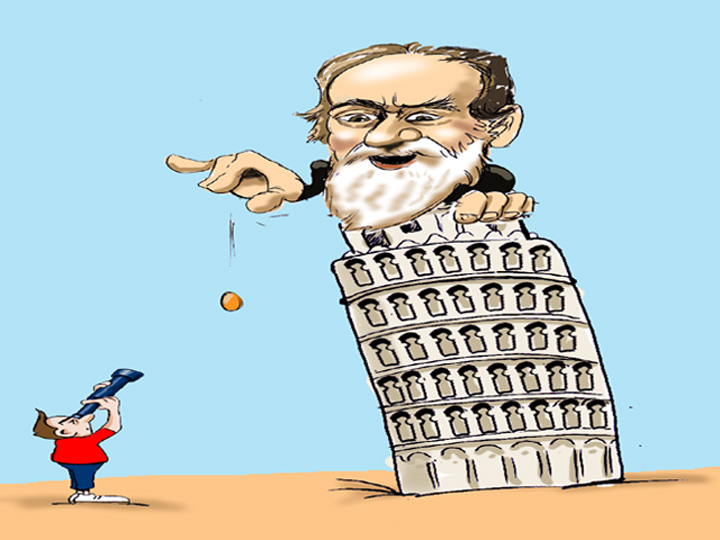
Galileo Galilei Biography and the Principles on Astronomy and Falling Bodies
Galileo Galilei Biography
Galileo Galilei was an Italian scientist whose contributions and works had made him one of the most significant scientists in introducing modern science. He is even known today as the father of modern science and the father of modern observational astronomy.
When and where was Galileo Galilei born?
Galileo di Vincenzo Bonaiuti de' Galilei, who is known today as Galileo Galilei, was born on February 15, 1564 in Pisa, Italy. He was the eldest among his siblings. His father, Vincenzo Galilei, was a music teacher and a lutenist. His mother was Giulia degli Ammannati. He had tutoring lessons with Jacopo Borghini before he was educated in a monastery which is in Vallombrosa, Florence. His father wanted him to become a physician.
Galileo Galilei University Life
In 1581, he entered the University of Pisa taking a medical degree. He was never inclined to study medicine and he preferred to pursue mathematics. It was Ostilio Ricci, one of Galileo’s mathematics teachers at the University of Pisa, who persuaded Galileo’s father to allow Galileo to study mathematics.
Galileo first taught mathematics in Florence in 1585. He also taught at Vallombrosa in 1586. In 1588, he was invited to lecture at the Academy of Florence through which he gained an excellent reputation. In 1589, he filled the post of Filippo Fantoni, one of his mathematics teachers at the University of Pisa, as the chair of mathematics. One of the incidents that led him to his discoveries on the pendulum was when he was observing a chandelier swinging back and forth while attending a service at the cathedral of Pisa. He noticed that the time it takes to complete one swing was always the same whether it was swinging fast or slow.
In 1591, Galileo’s father died and Galileo had to provide the rest of his family financially. In 1592, he was appointed at the University of Padua as a professor of mathematics and he received thrice as much salary as that which he was receiving at the University of Pisa.
Galileo Galilei Picture

Galileo Galilei's Telescope
In 1609, Galileo made his own telescope that could magnify around nine times and his claims included observing the moon and stars. In 1610, he became Chief Mathematician at the University of Pisa.
Galileo never married but he had three children with Marina Gamba. His two daughters, Virginia and Livia, were sent to a convent in Arcetri where they became known as Sister Maria Celeste and Sister Arcangela respectively. His son, Vincenzio, joined with him in Florence when Marina Gamba was married to another man.
The Principles on Astronomy and Falling Bodies
One of the significant contributions of Galileo Galilei to astronomy was his invention of the first telescope that is able to magnify up to thirty times. By using the telescope, he was able to study and observe heavenly bodies and images of the earth. His discoveries using his astronomical telescope have greatly helped preceding astronomers and scientists to understand and analyze the properties and attributes of different heavenly bodies.
What did Galileo see from his Telescope?
His claims include discovering the uneven surface and craters of the moon. The reflected light that shines from the moon enabled him to observe the mountainous surfaces of the moon. He was able to observe the stars in the Milky Way galaxy by noticing from his telescope that the universe is made up of numerous stars.
Galileo observed planets. He was the one who discovered the four moons of the planet Jupiter which are now called the Galilean moons. He observed the oval shape of the planet Saturn. He studied the planet Venus and showed that it undergoes a set of phases that is similar to the moon. According to Galileo, the planet Venus can be viewed in its set of phases from the earth. These observations and theories by Galileo supported the Copernican system.
Galileo observed the dark patches on the sun through his telescope and these dark patches are what are scientifically termed today as sunspots. His observation of the motion of these sunspots indicated that the sun is rotating on its axis.
Galileo also had Significant Contributions in the Field of Mechanics
Galileo discovered the law of falling bodies. His theory opposed the principles of Aristotle on falling bodies which states that when two objects with different masses are dropped at the same time from the same height, the heavier object will hit the ground first.
Galileo’s Law of Falling Bodies
Galileo proposed that falling bodies fall with uniform acceleration as long as there is a negligible resistance of the medium through which the bodies are falling or when falling bodies are only influenced by gravity. When a body is falling through a vacuum, there is a negligible resistance of the medium. He observed that two objects with different weights hit the ground at the same time when these objects initially fall from the same height. When two objects of different weight initially falling from the same height will not hit the ground at the same time, this is caused by the air resistance or the resistance of the medium that the objects are falling through. His theories include that the speed or motion of a falling body does not depend on its weight, density, and size.
Galileo’s law of falling bodies is described in the statement that “The distance travelled by a falling body is directly proportional to the square of the time it took to travel.”
He also stated a principle of inertia which states that “A body that is moving on a level surface will continue to move in the same direction with constant speed unless it is disturbed.”
His principle of inertia is associated with Newton’s first law which is the law of inertia.